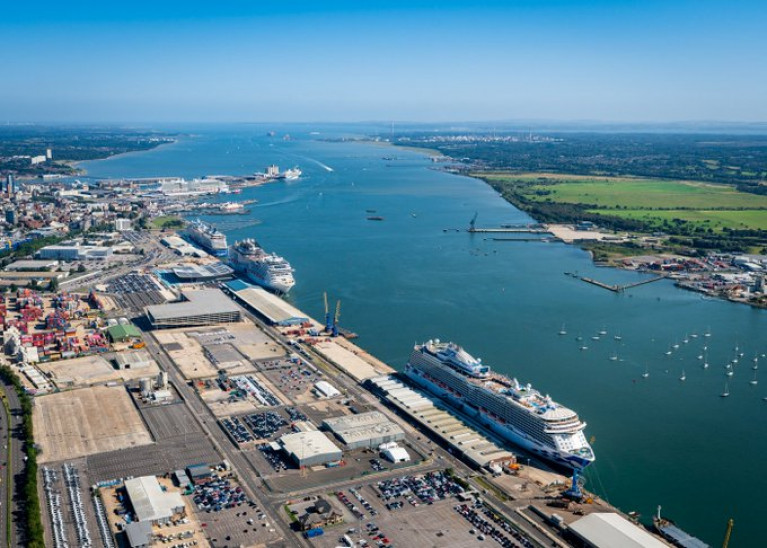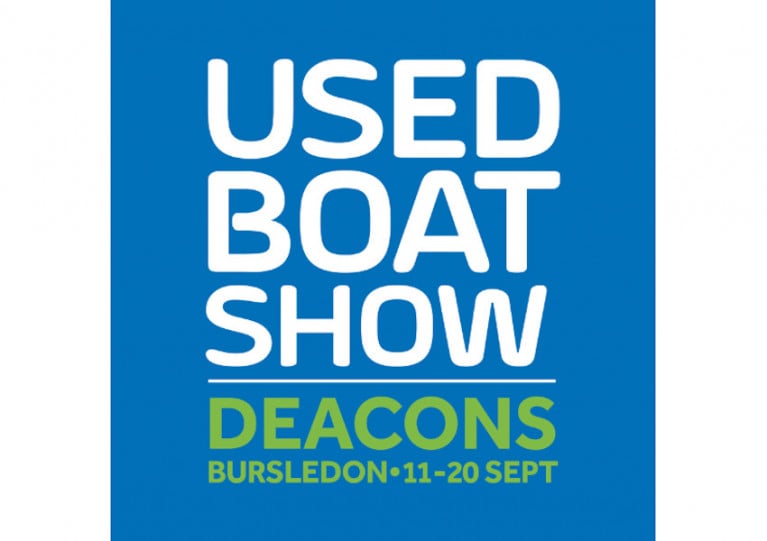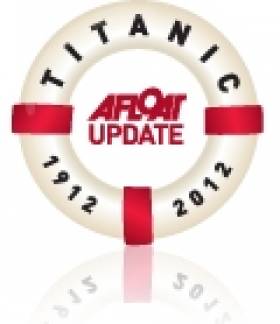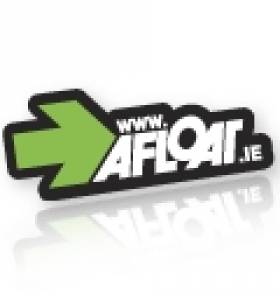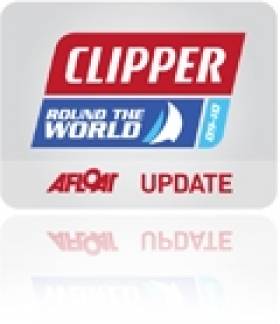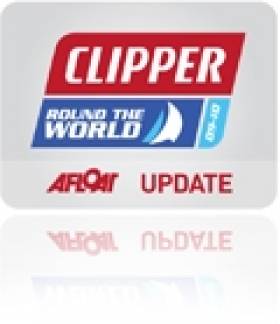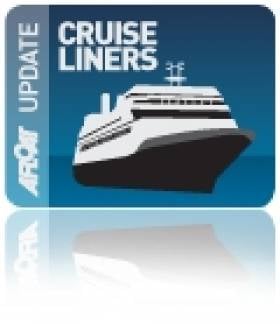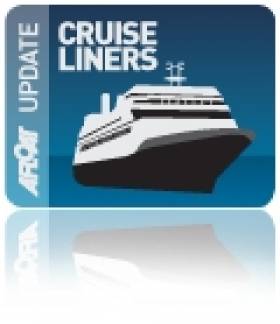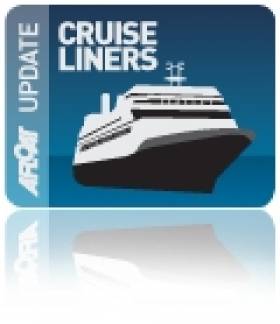Displaying items by tag: southampton
Safehaven Marine’s latest deliveries this month include a second pilot boat for Scotland’s Port of Cromarty Firth and a specialised vessel for port operations in Southampton.
Williams Shipping have taken delivery of an Interceptor 48 for crew transfer operations and pilot transfers in the Port of Southampton on the south coast of England.
Willfreedom is the Youghal-based performance boat builder’s 51st pilot boat delivered thus far. It’s powered by a pair of Scania DI13 500hp engines for an operational speed of 25 knots and boats remarkable fuel economy, using as little as 50l/phr from each engine at 20 knots.
 Willfreedom is Safehaven Marine’s 51st pilot boat delivered thus far | Credit: Safehaven Marine
Willfreedom is Safehaven Marine’s 51st pilot boat delivered thus far | Credit: Safehaven Marine
 Willfreedom’s central helm position is fitted with a full array of Raymarine navigation equipment | Credit: Safehaven Marine
Willfreedom’s central helm position is fitted with a full array of Raymarine navigation equipment | Credit: Safehaven Marine
Inside, the central helm position for optimal vessel control is fitted with a full array of Raymarine navigation equipment, while the Grammer shock mitigation seating ensures crew and passenger comfort, as does the full interior climate control.
Elsewhere, Safehaven’s 50th pilot vessel is Balblair, which joins Dalmore (delivered in 2019) as the second order from the Port of Cromarty Firth.
This variation is powered by twin Volvo D13 500hp engines with a “very economical” 25 knots operational speed, as well as a a full array of Furuno navigation equipment and full live-aboard facilities in the spacious lower forward cabin.
 Balblair alongside sister pilot boat Dalmore at the Port of Cromarty Firth | Credit: Safehaven Marine
Balblair alongside sister pilot boat Dalmore at the Port of Cromarty Firth | Credit: Safehaven Marine
Safehaven Marine’s managing director Frank Kowalski said: “A repeat order from a port is always extremely satisfying as it demonstrates the client’s full satisfaction with the boat and his confidence in our company, especially as the contract for Balblair came in the middle of a global pandemic.”
Full Cruise Operations Return at Port of Southampton Sees Consecutive Five-Ship Weekends
Following an easing back to full cruise operations at the UK's main cruise port of Southampton which had its busiest month of the year to date with two consecutive five-cruise ship weekends during August.
On Saturday 7 August and Saturday 14 August, each one of the port’s world-class cruise terminals was occupied as the cruise industry makes its phased return. This is welcome news for holidaymakers as well as for the thousands of local residents who rely on the cruise industry for their livelihood.
During the first five ships day, Ocean Cruise Terminal hosted P&O Cruises’ Iona. The new cruiseship later departed the ship's home port (see May's naming ceremony) for a maiden passenger cruise.
Marella Explorer departed from Queen Elizabeth II Terminal in the Eastern Docks, MSC Cruises’ MSC Virtuosa (Belfast's first bigship caller), fitted with Shore Power connectivity, was at the port’s newest terminal, Horizon Cruise Terminal.
Anthem of the Seas, Royal Caribbean’s second largest ship in its Quantum-class, was at City Cruise Terminal, and Regasothl Princess, Princess Cruises’ Royal-class ship, departed from the Western Docks Mayflower Terminal (adjacent to the Southampton International Boat Show, see story).
On the second weekend, Royal Caribbean’s Celebrity Silhouette was at City Cruise Terminal in place of Anthem of the Seas, with all other ships above returning to their respective terminals for further passenger operations. (These ships Afloat adds also visited Belfast Harbour this season).
Rebekah Keeler, Head of Cruise at ABP, said: “We’re excited to be getting closer to seeing what a ‘normal’ cruise weekend for the port in peak season would be. It’s taken a huge collaborative effort by the industry to bring cruise back safely and it fills us all with pride to see passengers once again beginning their holidays here at the Port of Southampton.”
Before the industry pause, the Port of Southampton would typically welcome two million passengers every year, with each cruise call bringing in over £2.7million into the local economy. The coming months are expected to be busy, with all terminals occupied at weekends and lots of activity on weekdays too.
With the new next-generation-ready Horizon Cruise Terminal now welcoming passengers, and its shore power due for commissioning this year, the strengthening of cruise infrastructure places the Port of Southampton firmly at the forefront of the future of cruise.
Used Boat Market Joins Southampton’s September Show Schedule
Preowned boats will get their own marketplace during next month’s boat shows in Southampton.
Why Boats’ Used Boat Show at Deacons in Bursledon on the Hamble will run from 11-20 September concurrently with Boats 2020, the ‘alternative’ event replacing this year’s Southampton International Boat Show, not to mention The Ocean Village Boat Show at MLD Marinas.
Open daily from 10am to 6pm, the Used Boat Show will showcase the range of used boats to visitors while maintaining all practical precautions against coronavirus, ensuring safety for show staff, sellers and potential buyers alike.
“It’s a great time for anyone who is looking to sell their boat,” says Why Boats director Ian Watkins. “The market is really buoyant and currently there is a real demand for used boats, both power and sail.
“Listing your boat for the show is very simple, just give us a call and we’ll do the rest.”
For a £150 listing fee, sellers will get a discount on commission (5% plus VAT) as well as a free lift, scrub and block off, one-month free storage ashore and 25% off storage ashore until 31 December.
For more details see WhyBoats.com
Cruiseship Call to Remember Belfast's Titanic
#TITANIC- In this centenary year of the R.M.S.Titantic's sinking, Fred Olsen Cruise Lines Balmoral is to include a port of call to Belfast Harbour, where passengers are to visit the Harland & Wolff shipyard, during an Easter mini cruise in early April, writes Jehan Ashmore.
Balmoral will be the first cruiseship to berth in Belfast this year and her passengers are to visit the world famous shipyard on Queens Island where the liner was built for the White Star Line.
In addition there will be opportunities to call to the Botanical Gardens, Ulster Museum and Belfast Castle. The three-night mini-cruise starts in Southampton and is to include an en-route call to Liverpool, a former City of Culture.
For further information on other cruise calls to Belfast as previously reported on Afloat.ie click this HERE. In addition to the Titanic Walking Festival (31 March-22 April) as also reported click HERE
Sold! Boats are Selling Despite the Downturn
In 2007 there were 70 Irish yacht and boat sales staff manning stands in Southampton, this week that figure was down by about 60%. No one needs reminding of recession and the drop off in boat sales has been a reflection of the hard times.
Confidence is returning to the market in spite of the dire warnings about currency crises and dealers are now beginning to take trade ins again but they're still cautious as they have little room for error.
The good news though for boat owners is that there is now some great value in the market and the Southampton Boat show is an example of that. A core of about 15 Irish dealers are doing business there, thanks in no small part to the availability of marine finance again.
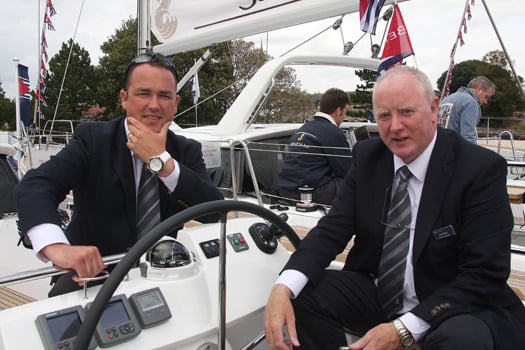
Boat Dealers James Kirwan (left) and Bernard Gallagher from BJ Marine on a new Benenteau Seanse in Southampton yesterday. BJ Marine are Irish Beneteau distributors
Interestingly, finance deals for values over €500,000 are 'brisk' but they remain sluggish for amounts under that, according to Afloat.ie's source.
That's surprising with the value of new craft on offer, such as a 2011 Beneteau Oceanis 48 footer at €209,000. A decade ago a boat with half that kit and of similar size would have been priced well over IR£350k. BJ Marine currently have three interested Irish parties in the 48 footer this week.
In essence dealers say that if you're prepared to drop your price on your trade in then you can probably make it back on a new purchase.
But just how much do asking prices need to drop? The amount varies between boat types but recently James Kirwan of BJ Marine sold a Beneteau Oceanis 39.3 for approximately €80k. An Oceanis 411 of the same vintage went for roughly €90k.
Alan Barton of MGM Boats in Kinsale sold a 2008 Jeanneau Sun Odyssey 39i recently for 125k. Two examples of nearly new Jeanneau Merry Fisher motorboats, a popular flybridge model in Ireland, fetched 75k and 85k approximately.
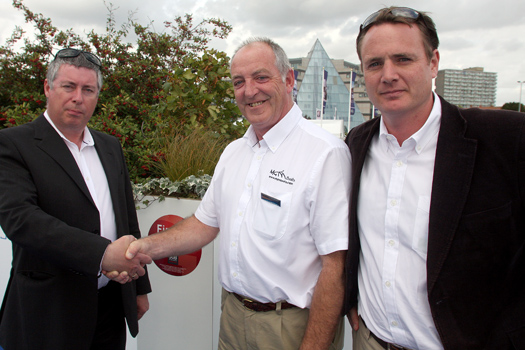
Martin Salmon (left) and Joe Hill welcome Alan Barton (centre) as the lastest broker to MGM Boats Ltd. Barton is running MGM Boats new brokerage office in Kinsale
Ironically, boat dealers have even been able to make progress through these bad times. Boats have not been as badly affected by the recession as other 'toys'. ' Unlike cars or property a boat is neither left hand drive or rooted to a particular spot making them easier to relocate and dispose of without resorting to fire sale prices' says BJ Marine's Bernard Gallagher.
In fact the worse the news grew about Ireland, the more business Irish dealers were able to do did as international buyers took advantage of the siutation to bag a bargain.
The trend is confirmed in part by the amount of search traffic coming from Scandinavia on leading Irish Boats for Sale sites such as Afloat.ie.
Swedish buyers are buying boats from 15k to 500k but most interest from Sweden is in five year old yachts in the 30-40 foot category.
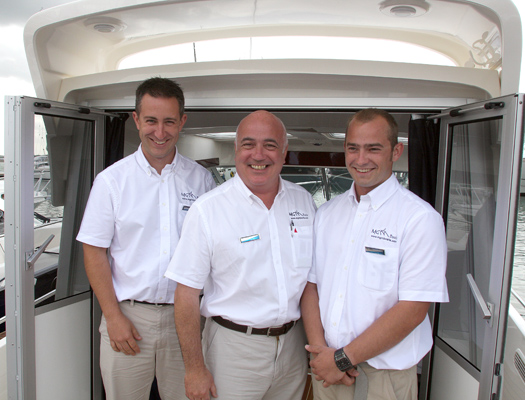
Mark White, John O'Kane and Glyn Dewey from MGM Boats on the new Aquador 25 in Southampton. MGM are the UK and Irish distributors for the Finnish made Aquador motorboat marque
In terms of asset types, the old adage that if you want to make money buy a house, lose money buy a car or keep money buy a boat does not quite ring true thanks to the property crash but there's still some truth in it for boats.
'Over the last seven years I bought two apartments, a load of shares and the boat. The apartments are under water, the shares are gone but the boat's still worth something' that's what one rueful Irish boat owner told Afloat.ie yesterday.
The advent of boats for sale websites is allowing Europeans a European wide selection to choose from and Ireland has been the focus because of the good value.
Such has been the exodus of used boats from Ireland to overseas markets that Gallagher says there is a dearth of quality used large craft for sale in Ireland now.
The Southampton boat Show continues until Sunday but be warned the cost of flights from Dublin directly to Southampton for a day return this weekend are running at over €300!
Royal Navy to Start Clipper Race from Southampton
With one week to go until the gun fires to signal the start of the Clipper 11-12 Round the World Yacht Race, the first global event to set off from the Solent since 2004, organisers are thrilled to welcome the Royal Navy's helicopter carrier, HMS Illustrious, which will attend the weekend's festivities in Southampton, culminating in the race start on Sunday 31 July.
Ireland is represented by the City of Derry entry. The race will stop there in its course around the world.
At 40,000 miles Clipper 11-12 is the world's longest yacht race and almost 500 people from all walks of life and representing more than 40 nations will take part, putting their everyday lives on hold to take on the challenge of a lifetime. More than 40 per cent of them had no sailing experience before beginning their rigorous pre-race training.
Commanding Officer of HMS Illustrious, Captain Jerry Kydd, said, "HMS Illustrious is delighted to be in Southampton to support the start of the Clipper Round the World Yacht Race. The Clipper Race stands for much of what the Royal Navy and Royal Marines hold dear: personal determination and fortitude, in dangerous and demanding conditions, where teamwork, resilience and a winning spirit overcome any challenge the crews may face on their adventure. On behalf of the officers and crew of HMS Illustrious, I wish all yachts and their crews the very best of luck for a safe and fast circumnavigation and a cracking race!"
Founder and Chairman of the Clipper Race, Sir Robin Knox-Johnston, the first man to sail solo and non-stop around the world, said, "The Clipper Race has always had a very strong relationship with the Royal Navy and I am very pleased to welcome HMS Illustrious for the start of Clipper 11-12. She is part of the large maritime community of the south coast and I am very keen that as many members of that community as possible are able to enjoy this event which promises to be a quite spectacular sight."
Many boat owners and sailing enthusiasts will be joining the flotilla of spectator boats to watch the parade of sail in Southampton Water from 2.30pm – where the ten ocean racing yachts will sail in formation ahead of HMS Illustrious – before the race begins at 4.30pm from the historic Royal Yacht Squadron line.
HMS Illustrious will arrive in Southampton on Saturday 30 July and will be berthed at the QE2 Terminal. A raft of free, family friendly entertainment is taking place over the weekend in Ocean Village where the ten 68-foot yachts contesting Clipper 11-12 will be based. Live music will include sets by Southampton groups, Delays and Parade, as well as Toploader, who will headline on Friday night. As well as the live music on stage other entertainment in the Race Village will feature African dancers, acrobats, drummers and fire eaters plus a spectacular fireworks display on Saturday night.
Tens of thousands of people are expected to visit the race village between Thursday 28 July when the yachts arrive and Sunday 31 July when the teams will say an emotional farewell before setting off on their 12-month circumnavigation. The course will take them to 15 ports on six continents and across the largest and most ferocious expanses of water on the planet. Each of the colourful yachts bears the name of the city, region, country or company it represents.
Southampton City Council and MDL Marinas, owner of Ocean Village Marina where the yachts will be berthed, are working in partnership to host the Clipper 11-12 race start, the eighth edition of the event established by Sir Robin to give people from all walks of life the opportunity to take part in the life-changing experience of ocean racing.
As the official host port for the race start Southampton can expect a significant economic return from the tens of thousands of visitors expected to visit the city over the four days the fleet will be in Southampton, delivering millions of pounds worth of revenue for local businesses.
The Clipper 11-12 Round the World Yacht Race will start from the historic maritime city of Southampton on the south coast of England on Sunday 31 July 2011. At 40,000 miles the event is the world's longest sailing race and will take the ten identical 68-foot ocean racing yachts almost a year to complete their circumnavigation of the globe.
Ireland has an entry in the race sponsored by the City of Derry.
Southampton City Council and MDL Marinas, owner of Ocean Village Marina where the yachts will be berthed, are working in partnership to host the Clipper 11-12 race start. It will be an atmospheric, colourful affair as crews bid an emotional farewell to family and friends at a shore-based ceremony before a stunning parade of sail by the yachts as they head to the start line.
It is the first time since 2004 that a round the world yacht race has started from the iconic sailing grounds of the Solent and promises to provide a breath taking spectacle for spectators both on the water and watching from the shore.
Southampton will be the fifth UK venue to host the race start. The Clipper Race celebrates its 15th anniversary this year and first set off from Plymouth in 1996. Two editions later the fleet started from Portsmouth before moving to Liverpool for the subsequent three races and then to the Humber on the UK's north east coast.
As the official host port for the race start Southampton can expect a significant economic return from the tens of thousands of visitors expected to visit the city over the four days the fleet will be in Southampton, delivering millions of pounds worth of revenue for local businesses.
This will be the eighth edition of this unique event which is 'raced by people like you'. More than 500 people from all walks of life and representing more than 40 nationalities will take part. Around 40 per cent of them had never set foot on a boat before beginning the compulsory pre-race training to prepare them for the gruelling challenge of racing across the world's fiercest oceans.
The race was created by British sailing legend, Sir Robin Knox-Johnston, the first man to sail solo and non-stop around the world. Since the first edition in 1996 almost 3,000 people have taken advantage of the opportunity to race across oceans in a challenge unlike any other.
Sir Robin says, "Fewer people have raced around the world than have climbed Mount Everest; it remains one of life's great challenges and experiences. Over the last 15 years we have discovered the power of the race to change not only the lives of our crews, but we have also seen it transform perceptions and prospects for the participating global cities, regions and countries.
"The Clipper Race creates a powerful platform at ports of call around the world where our destination sponsors and their partners can network together to develop international trade, promote tourism and celebrate culture."
Each of the ten yachts is sponsored by a city, state, country or company who leverage their participation with trade, tourism and cultural programmes, building on successful pilot initiatives which have seen deals done, trade agreements signed, tourism enquiries generated, universities promoted, knowledge exchanged, cultures shared and powerful economic impact generated on top of extensive international media attention. Clipper 09-10 was seen by a cumulative global audience of more than half a billion people.
Sir Robin adds, "I am particularly pleased that Southampton is to host the start of Clipper 11-12 and that for the first time in many years the very active sailing community in the Solent will be able to be part of a round the world yacht race."
Councillor Royston Smith, Leader of the Council, said, "Southampton City Council is proud to be supporting this race. This internationally renowned event will attract tens of thousands of people of all nationalities to Southampton, generating millions of pounds for the local economy. This is a fantastic opportunity to showcase all that Southampton has to offer to an international audience. Southampton's reputation as a destination of choice is growing, and events like this will only enhance that reputation further. We are also a centre of maritime and marine innovation – a fitting location for the start of this race."
In the build up to the start of the race the fleet will be based in Ocean Village, Southampton, and high profile events for international delegations to the event will also be held in the city.
Dean Smith, Marketing Director at MDL Marinas, commented, "We are delighted that Ocean Village Marina has been selected as the official host port for this phenomenal race and are really looking forward to bringing together thousands of people to celebrate the landmark event. It really is great that this year's race will start from the renowned boating haven of Southampton, which is synonymous with ocean racing, with Ocean Village playing host to round the world races starts and finishes for the likes of Whitbread and Challenge, as well as arrivals from Ellen MacArthur and Dee Caffari. The whole team at MDL is looking forward to looking after the fleet at the marina before cheering them on as they set sail on 31 July."
Already confirmed for Clipper 11-12 are the Keppel Corporation-sponsored Singapore and, representing China's Olympic sailing city, Qingdao, both entering the race for the fourth time. Qingdao is twinned with Southampton. Returning for their second appearance are Visit Finland, backed by the Finnish Tourist Board, and the Scottish entry, Edinburgh Inspiring Capital. And, making their debut in the race, are Derry-Londonderry, celebrating their status as UK City of Culture 2013, and De Lage Landen, the global provider of asset-based financing programmes, which will race under the Dutch flag. The names of the remaining four yachts will be revealed in the coming weeks ahead of the race start.
The international fleet will visit 14 ports on six continents during the 12-month race. Starting from Southampton the route takes them to Madeira, Rio de Janeiro, Cape Town, the west and east coasts of Australia, New Zealand, Singapore, Qingdao, California, New York, Nova Scotia, Derry-Londonderry and the Netherlands before returning to the south coast on 22 July 2012.
A few places are still available for people wishing to take part in Clipper 11-12 and berths are now released for Clipper 13-14 and beyond. Participants must be 18 years old and over and there is no upper age limit. No sailing experience is required. For more information visit the official race website: www.clipperroundtheworld.com
A floating crane-barge with a 1,000 ton lifting capacity hoisted the structure sky-high away from the ship which was berthed at the Grand Bahama Shipyard drydock facility. The ships owners, Princess Cruises cited the main reason for the removal was in order to 'significantly improve the operational performance of the ship, including greater fuel efficiency.'
Grand Princess may have lost her signature Skywalker Nightckub but three-decks below a new nightclub, One5, inspired by its Deck 15 location was created. In addition to this work which took place during April and May the 2,600 passenger cruisehip also underwent a major refit. The ship which had its last major refurbishment in 2004 has amenities to include an outdoor movie screen, fitness centre, spa, casino and four swimming pools.
For 'interactive' deckplans click here and interior slideshow click this link.
The distinctive 'Skywalker' feature became one of the most iconic in cruiseship naval architecture when the Grand Princess was launched as leadship
of the 'Grand' class in 1998. Located at the extreme aft of the vessel, the nightclub could only be reached by clubbers using an angled walkway (photo). Externally the feature was referred by some as the 'shopping trolley' and others percieved the design infleunce from towering poops found on ancient war-faring galleons.
Irrespective of the design origins, another 10 'Grand' class vessels were built by the Italian Fincantieni (at Malfalcone) Shipbuilding Group. The 'handle' (photo) feature on the Grand Princess was made with a heavier material compared to Golden Princess (2001) and Star Princess completed a year later. So there are no plans to remove these nightclubs. Of the more recent additions to the class modifications have appeared, notably without the inclusion of the Skywalker Nightclub's but there are changes to funnel designs.
Outside the Princess Cruises brand, the Ventura and Azura (also of the Grand-class) operate for P&O Cruises, serving the UK market from Southampton. The Hamsphire port welcomed the pioneering leadship Grand Princess on 5 May after she made a 16-day trans-Atlantic repositioning voyage from Port Everglades.
The cruiseship which has a crew of 1,200 alone will make the UK port its seasonal homeport this year from where she sails on cruises in Europe. On one of these cruises itineraries the Grand Princess (290m long x 36 beam X 8.5m draft) included a visit to the Port of Cork today. You can monitor the ship from Cobh Cruise Terminal via the 'live' bridge web-cam, noting the vessel is due to depart at 18.00 this evening bound for Dublin Port.
Grand Princess became the first cruiseship to measure over 100,000 gross registered tonnes when the 108,806 (grt) vessel docked in Dublin on 31 August 2004.
Last year the port handled 88 cruisecalls and this number of vessels is to be closely repeated this season. Over 200 cruise calls with around half a million passengers and crew are scheduled to visit the island of Ireland. The cruise sector business is estimated to generate €60m to the economies
north and south.
The near 700-passenger capacity ship operated by UK based Voyages of Discovery is scheduled to call at several Scotish ports before returning to Portsmouth via the North Sea.
Discovery has eight decks with facilities to include two swimming pools, one with a retractable roof, jacuzzis, lounges, bars, a library and gymnasium, lecture theatre, cinema, restaurants, an internet cafe, shop, beauty salon and a medical centre.
She was built in 1971 as the Island Venture, then renamed Island Princess after purchased by Princess Cruises, alongside her sister Pacific Princess which appeared in the popular US TV series sitcom the 'Love Boat' broadcast by ABC between 1977-1986.
In total there will be four cruise-calls during the season to Douglas but the next visit will be not until July when P&O Cruises Adonia calls on the 17th. The ten-year old 710 passenger vessel is due to be named by Dame Shirley Bassey at a ceremony held in Southampton later this month.
Also calling to Douglas will be Oceania Cruises brand new 60,000 tonnes / 1,250 passenger Marina on the 24th July and the final call is to be made by Noble Caledonia's Japanese built Clipper Odyssey in mid-August.
- Killybegs
- Cork
- Discovery
- Marina
- Ringaskiddy
- Cruise Liners
- Princess Cruises
- southampton
- Isle of Man
- P&O Cruises
- Ports and Shipping News
- Manx
- Voyages of Discovery
- Douglas
- Douglas Bay
- Adonia
- Dame Shirley Bassey
- The 'Love Boat'
- ABC
- Pacific Princess
- Island Princess
- Oceania Cruises
- Cruise Liner news
- Clipper Oydessey
- Noble Caledonia
First Cruise-Caller of the Year
Onboard the ship which caters mostly for the UK market, asides the interior facilities there are the outdoor leisure amenities located on the Lounge Deck which has two jacuzzis and an exercise pool. There is also a large swimming pool and weather permitting a poolside buffet is also available at meal times. In addition a circular pool is located on the Marque Deck.
She alongside sister Black Watch belong to a four-ship fleet of the Norwegian owned company. Boudicca was built in 1973 and for many years served as Royal Viking Star as part of a trio of German built sisters for Royal Viking Line. The 205m long vessel underwent her last major refit in 2006.
Boudicca will remain berthed in Dublin's Alexandra Basin until she sets sail later this afternoon for the short overnight cruise-leg to Liverpool.
Last year Dublin Port handled 88 cruisecalls and this number of cruise-callers is to be closely repeated in 2011. Overall there will be over 200 cruise calls with around half a million passengers and crew scheduled to visit ports and anchorage locations throughout the island of Ireland. The cruise sector business is estimated to generate €60m to both the northern and southern economies.


























